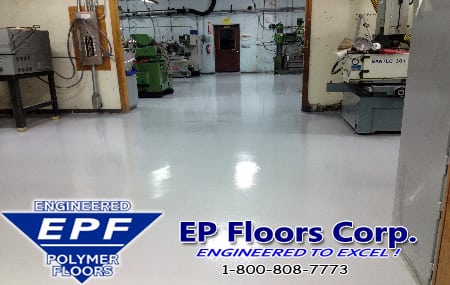How to Prevent Pitfalls When Buying Epoxy Flooring
Disadvantages of Epoxy Flooring & How to Prevent Pitfalls When Buying
Epoxy flooring and industrial flooring have many features that can greatly enhance your facility, and provide an excellent return on the investment. However, sometimes there can be disadvantages of epoxy flooring and problems with the results, when purchasing epoxy floor coating systems.
So what is it, that can cause epoxy floor projects to fail?

Here are some of the most common reasons:
- Inferior Surface Preparation
- Weak Substrate
- Wet or damp substrate.
- No Primer
- Mechanical Loading Exceeds Strength of Coatings
- Incompatible Substrate
- Oil Saturated Concrete
- Incorrect Mixing
Inferior Surface Preparation
–Surfaces needs to be properly prepared.
After preparation, it must be:
Clean, Dust-Free and Dry
–Surfaces must always be prepared with diamond grinder, shot blaster, or scarifier.
–Ensure that the water vapor emission level, from the concrete, is below 3 lbs per square foot.
Subtrate too Weak
When the epoxy floor system is removed, concrete should be adhered to the bottom of the epoxy. However, if the concrete substrate is week, the failure will not occur at the bond line, but within the substrate itself. This is a sign of inferior quality concrete.
No Primer
Most seamless resinous flooring systems require an appropriate primer, for maximum adhesion.
Mechanical Loading Exceeds Strength of Coatings
One should not assume the epoxy flooring products will last. Does the system have a track record in similar environments?
Incompatible Substrate
Make sure the substrate is compatible for epoxies both in terms of adhesion as well as tensile strength.
Wood, metal, & tile surfaces must be carefully inspected, and determined suitable for adhesion and structural integrity, prior to overlaying.
Oil Saturated Concrete
If the building/area has had various uses, over the years, check the history. Problems can occur in old concrete which come back to haunt the new owner/tenant (for example: former companies that performed machining operations, may have contaminated the concrete with oils. If this occurred, the depth/extent of oil contamination must be determined, in order to determine an appropriate solution. You do not want to install an epoxy floor coating over the old contaminated floor. In order to adhere coatings, all oil, grease and residue thereof must be properly removed, before attempting any type of fresh coating. In order to adhere coatings, all oil, grease and residue thereof must be properly removed, before attempting any type of fresh coating.
Incorrect Mixing
This can cause a multitude of problems and disadvantages of epoxy flooring: Faulty resin/hardener ratios, too short mixing time, improper mixing of components.
With proper research and caution, these issues may be prevented, by selecting a trained and experienced flooring applicator. The facility specifier shall then enjoy the long lasting durability, aesthetics, ease of cleaning, and low maintenance costs, of epoxy flooring.
About the Author:
Craig O’Shea, Project Manager with EP Floors Corp., has almost 30 years of experience in the epoxy flooring business. He attends technical training seminars regularly, on the latest industrial flooring innovations, and has managed over a thousand epoxy flooring projects. For more information Craig may be reached at https://epfloors.com/ or by email at craig86575@gmail.com




